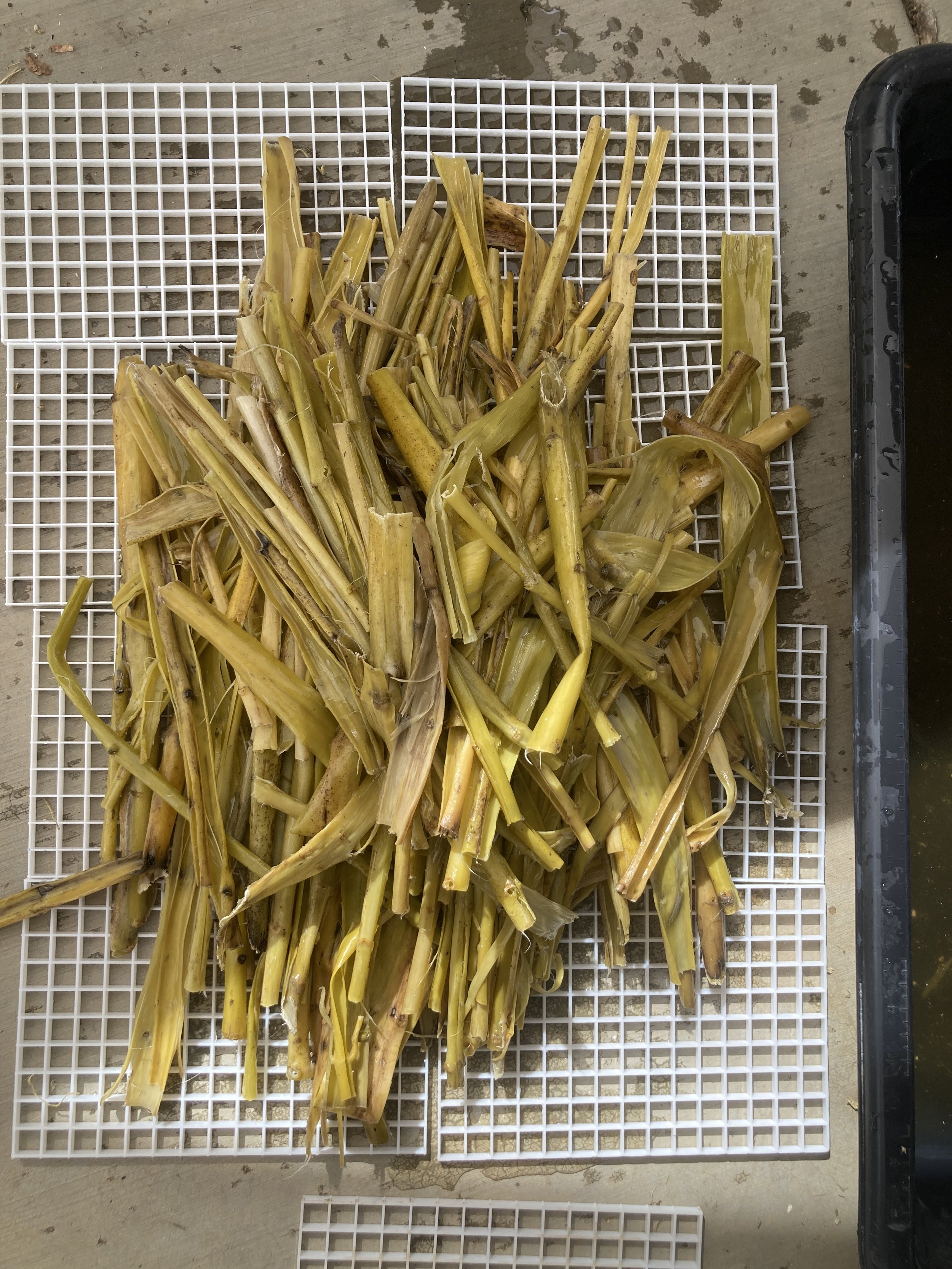A long overdue post on Part 2 of my milkweed adventure, which took place in October 2023.
It took about a week to process the trunk full of milkweed stalks that I had harvested from Hedgerow Farms. Since the stalks were fresh, I knew I had a narrow window of time in which to work. I enlisted the help of Winnie, Gaboo, and Deb. First we sorted the stalks and cleaned off extraneous leaves, and trimmed the stalks to a uniform size. This work took about a day and a half:
It was amazing to work with this fresh plant material, still so full of life:
Milkweed floss and seeds from inside a pod.
The next step was steaming. I went to several restaurant supply places to look for a giant steamer, and managed to cobble together a steaming apparatus using the largest pot I could find plus a makeshift steamer basket. I realized that the size of the stalks needed to be cut down to whatever size the steaming apparatus could hold, so had to trim stalks even further to fit inside the pot. My initial setup was short (~10”) stalks in bundles, lying down in the steamer. For this first day of steaming and stripping, we got help from new friends Sky and Tianyi. I had met Sky at one of the Korean diaspora hanji workshops, and thankfully their flexible schedule allows for them to show up on a random weekday:
short bundles of milkweed stalks, inside the steamer
close-up of the stalk layers while stripping from the core
Tianyi demonstrating how to strip the outer layer of the stalk from the core, which is considerably easier once it has been steamed for about an hour.
The following day, I had the pleasure of hosting Alyssa and her partner Adam, who both eagerly took part in the milkweed processing. They live in NC but were on vacation in CA. Alyssa is a friend that I met at Penland a few months prior; here is a pic of us from Penland, May 2023:
look at us, so carefree in the Penland field
It is such a joy to be around other craft people, making discoveries, taking delight in what natural materials yield, sharing techniques and experiments. Alyssa tends to ferment her plant material for papermaking (as opposed to steaming) which I tried but failed to follow through. Maybe next year.
Above is a photo of Alyssa showing off the silky bast, which is the key ingredient for papermaking, holding tons of cellulose.
I tried a different steaming method, a pot on the bottom and an upside-down pot at the top as a lid, with aluminum foil to fill in the gap in the middle, so that we could keep the stalks longer and upright. It seemed a bit more hazardous and unstable and haphazard, at least the way I set it up, though I do think if I had a bigger pot I would much prefer for the stalks to stand upright.
I like this photo that Alyssa captured of me behind the asparagus-looking milkweed stalks. It looks like I’m dancing, but most likely I’m trying to figure out how to get the hot lid back on without burning myself.
A few days later, a couple more local friends Esme (the one who originally connected me to Hedgerow Farms) and Talon, a new Korean American friend, came to help with the last of the stripping:
Talon stripping stalks while Esme tries scraping
Here are all the ways that the stalks looked in various stages of “doneness” (either freshly stripped, laying out to dry, hanging to dry):
From left to right: stalks that have yet to be steamed and stripped, woody cores in the middle, stripped stalks, ready to be hung to dry on the right
I remember it rained that weekend, as you can see by the gray clouds rolling in below. I think I had left the milkweed out to hang despite the rain, and perhaps that is why so much of the milkweed stalks developed mold/black spots in the drying out process. I’m not sure.
Winnie tending to the milkweed stalk bundles
Eventually I dried out all of the stalks and weighed them - approx 28 oz, or 1.75 lb. I stored them away in my studio, where they sat for many months. My next post will cover the next phase of processing the milkweed, which took place in the summer of 2024.





















